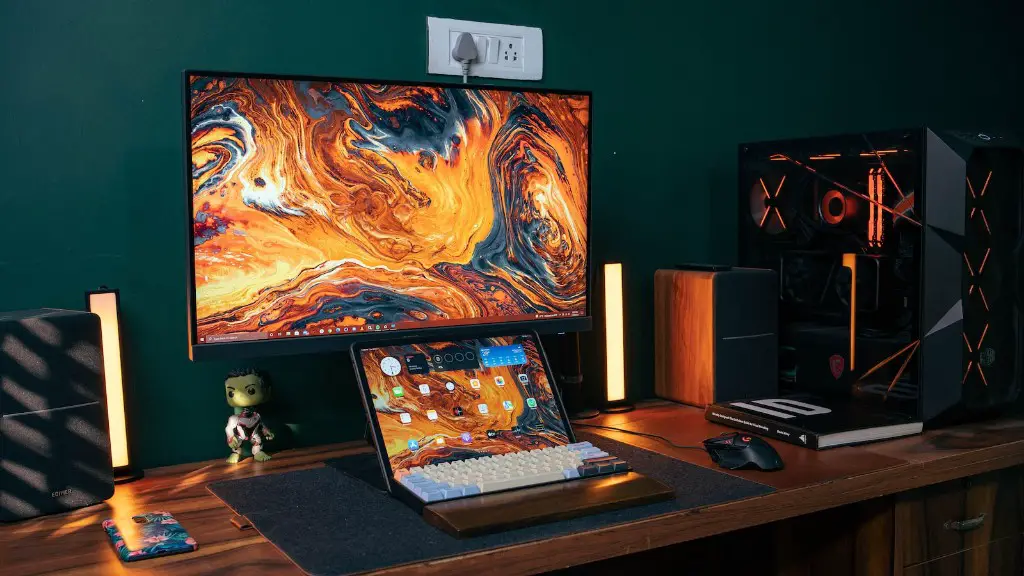For a serious gamer, having a top-of-the-line gaming monitor is essential to their gaming experience. The monitor must have excellent picture quality, fast response rate, and low input lag to ensure that the game appears fluid and smooth every time. There are a few key things you should consider when shopping for a gaming monitor.
Contrast ratio is one of the most critical aspects of a good gaming monitor. A high contrast ratio will result in deeper blacks and richer colors for a stunning image quality. Additionally, a higher contrast ratio will create deeper shadows in dark scenes for a cinematic feel.
Response time is also important for gaming. A fast response time minimizes ghosting and motion blur and will allow the game to look clean and colorful. A low response time is especially important for fast-paced games and intense action.
Input lag is another factor to consider. Input lag is the time it takes for the monitor to render a new image, so the lower the input lag, the better the gaming experience. Low input lag helps ensure that the game runs smoothly without any noticeable frame rate drops.
Another feature that a gaming monitor should have is Adaptive Sync. Adaptive Sync eliminates tearing and stuttering and ensures that the monitor is always in sync with the graphics card. This ensures that the game always looks its best and runs smoothly.
Finally, it’s important to consider the type of panel used for the gaming monitor. There are two main types of panels: TN and IPS. TN panels have a lower response time and are better for fast-paced games, while IPS panels have better color accuracy and viewing angles and are better for more traditional games.
When it comes to gaming monitors, it’s important to consider the contrast ratio, response time, input lag, Adaptive Sync, and type of panel used. All of these factors will play an important role in determining how well the game runs and how good it looks.
How To Choose The Best Gaming Monitor
Choosing the best gaming monitor is a tricky endeavour, as there are many factors to consider. It is important to assess the various specifications of a monitor before selecting the one that fits your needs the best. Different features will come into play depending on the type of games that you are playing and the hardware that you are using. Here are the main points to consider when selecting the best gaming monitor.
The refresh rate of a gaming monitor is an important factor to consider. The higher the refresh rate, the smoother the gaming experience. Most monitors are available in 60Hz, 75Hz, 100Hz, and 144Hz refresh rates, so you need to choose the one that best suits your hardware limitations and playing style.
The resolution is another factor to consider. The higher the resolution, the sharper the image quality, which is beneficial for competitive gaming and for enjoying the details and sights of your game. Monitors with 4K resolution are the best for discerning gamers, although this may not be necessary for everyone.
The panel type is also an important factor to consider. For gaming, it is best to choose an IPS panel, as they provide the best overall picture quality and the best viewing angles. However, TN panels offer the lowest input lag, which is beneficial for fast-paced games. It is up to you to decide which panel type best fits your gaming needs.
The response time is also important for gaming purposes. The response time is the amount of time it takes for the monitor to refresh the image, so the lower the response time, the less blurry the image will be and the more vibrant the colors will look. If a monitor has a high response time, it will result in ghosting and motion blur.
Another important factor to consider when choosing the best gaming monitor is the size of the panel. Depending on your budget, you can choose monitors of various sizes, ranging from 21” all the way up to 43”. For most gamers, a 27” or 32” monitor is the sweet spot, as they offer the best balance between cost and performance.
Finally, it is important to look at the color accuracy of the monitor. For maximum accuracy, look for a monitor with a Delta E rating of less than 3. This is especially important for gamers who are interested in color-accurate gaming or professional graphic design.
Benefits of a Good Gaming Monitor
Having a good gaming monitor is essential for gamers looking to get the most out of their gaming experience. A good gaming monitor can provide a range of benefits, from improved visual clarity to increased performance. Here are some of the main benefits of a good gaming monitor.
The most obvious benefit of a good gaming monitor is the improved gaming experience. With a good gaming monitor, you can enjoy improved visuals, faster response times, lower input lag, and better image clarity. This makes games look and feel the best they possibly can.
Another benefit of a good gaming monitor is greater comfort. Gaming can often be a long and strenuous activity, and having a good monitor can reduce eye strain and reduce fatigue. A good monitor should have low flicker rates and a blue light filter, both of which can reduce eye fatigue.
A good gaming monitor will also provide better colours and contrast. A brighter display will make the image pop more, and higher contrast ratio and deeper blacks will make the image look more cinematic. This improved picture quality will give you an even better gaming experience.
Finally, a gaming monitor with higher refresh rates can also help improve gaming performance. The higher the refresh rate, the faster the frames per second, which makes games look smoother and more responsive. This is especially apparent in fast-paced and competitive games, such as first-person shooters and fighting games.
Types of Gaming Monitors
When it comes to gaming monitors, there are a few different types to choose from. Here are the main types of gaming monitors and their main features.
The most popular type of gaming monitor is the TN panel monitor. These are the most affordable and they offer the lowest input lag and the fastest response time, making them great for fast-paced games. However, they are not the best when it comes to color accuracy and viewing angles.
The next type of gaming monitor is the IPS panel monitor. These are more expensive than TN panels but they offer significantly better colour accuracy and viewing angles. They have slightly higher input lag and slower response times, which make them better for more traditional games.
The next type of monitor is the VA panel monitor. These offer greater contrast ratio than both TN and IPS panels, making them the ideal choice for movies and other cinematic games. They have higher input lag and slower response times than TN panels, so they are best for gamers not looking for competitive gaming.
Finally, there are curved gaming monitors. These monitors offer a more immersive experience, as they wrap around the user’s field of view. They are best for simulators and driving games, and they are also good for players looking for a more cinematic experience.
Gaming Monitor Performance
For gaming purposes, it is important to look at the performance of a gaming monitor. This includes the response time, input lag, and refresh rate. The response time is the amount of time it takes for the monitor to refresh the image, so the lower the response time, the better. Input lag is the time it takes for the monitor to render a new image, so the lower the input lag, the better. And, finally, the refresh rate is the number of times the monitor refreshes the image per second, so the higher the refresh rate, the better.
A good gaming monitor should have a response time of 5ms or lower, an input lag of less than 10ms, and a refresh rate of at least 60Hz. However, for competitive gaming, it is best to aim for a response time of 1ms or lower, an input lag of less than 5ms, and a refresh rate of at least 144Hz. Higher refresh rates are becoming increasingly common, with 240Hz and even 360Hz monitors now available.
When it comes to performance, there are a few other factors to consider as well, such as the Adaptive Sync technology, the type of panel used, and the color accuracy. Having a monitor with Adaptive Sync will reduce screen tearing, stuttering, and judder and keep the monitor in sync with the graphics card. The type of panel used will affect the image quality, with TN panels offering lower response time and IPS panels providing better colors and viewing angles. Finally, the color accuracy of the monitor will affect the accuracy of the colors, with a Delta E rating of less than 3 being ideal.
Conclusion
When shopping for a gaming monitor, it is important to consider a range of factors to ensure you get the right monitor for your needs. Key factors to consider include the refresh rate, resolution, response time, input lag, Adaptive Sync, and panel type. Additionally, the size and color accuracy of the monitor are also important. The type of games you intend to play and the hardware you use will play a large role in determining what features you need in a monitor. With a bit of research and patience, you can find the right gaming monitor for you.



